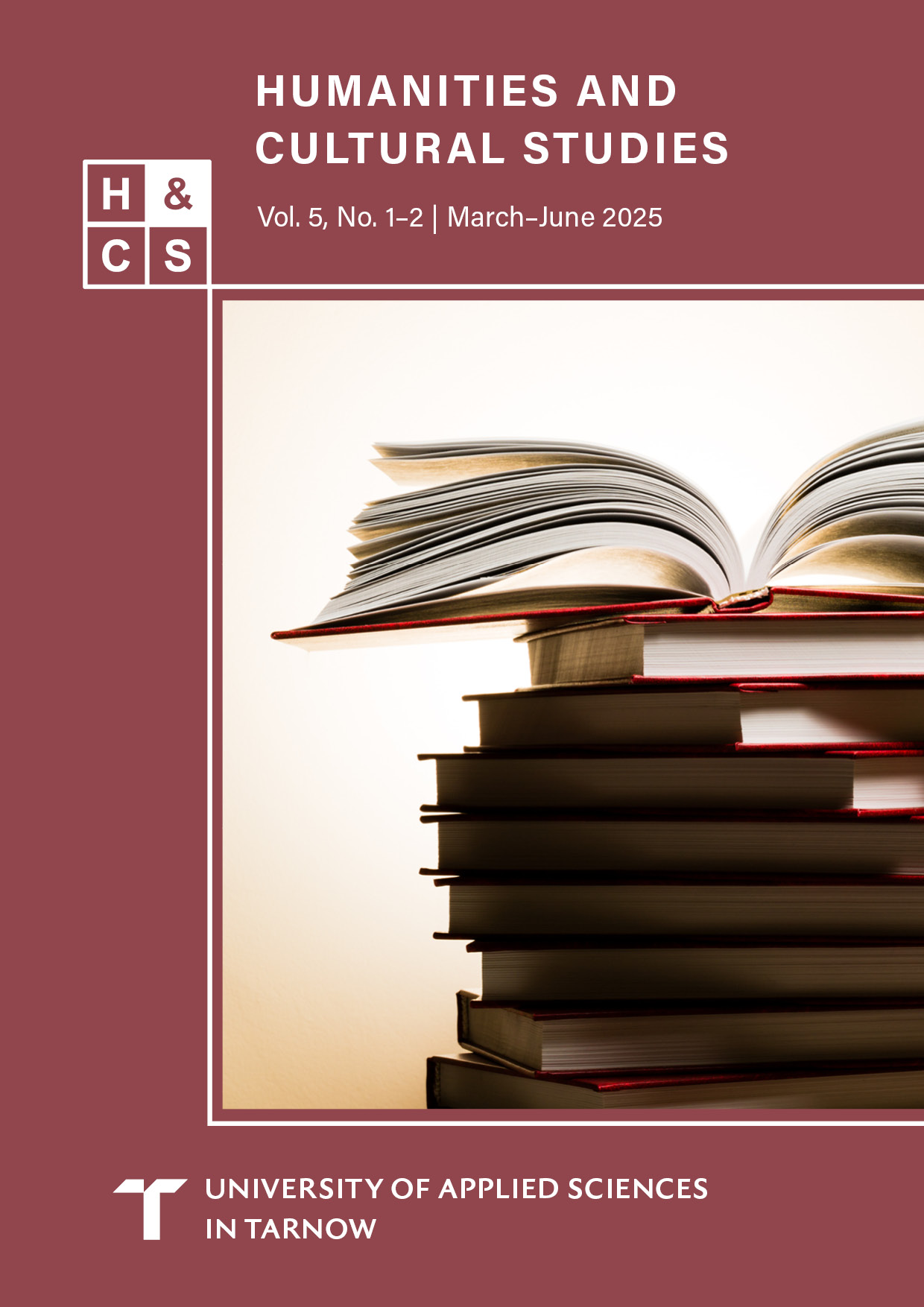Tekstowa perspektywa mitologii Sylvii Plath
historia i interpretacje "Ariela"
DOI:
https://doi.org/10.55225/hcs.680Słowa kluczowe:
Ariel, biografia, mitologia literacka, krytyka tekstu, mity Plath, Sylvia PlathAbstrakt
Pośmiertna publikacja tomu Ariel Sylvii Plath w 1965 roku zapoczątkowała powstanie mitu Plath, splatając jej tragiczną śmierć z odbiorem jej twórczości. Podczas gdy wielu krytyków, zwłaszcza o feministycznych poglądach, próbowało odejść od napędzanej biografią dychotomii szalonej kobiety/geniusza, często nieświadomie utrwalali mit, ciągle skupiając się na kontekstach biograficznych, a nie na twórczości Plath. W niniejszym artykule przeanalizowano przełomowy esej Marjorie Perloff z 1984 roku, zatytulowany The Two Ariels, w którym autorka krytykuje wpływ redaktorski Teda Hughesa na tom Ariel, argumentując, że jego zmiany zniekształciły zamierzoną przez Plath narrację o kobiecej wściekłości i nadziei, kładąc nacisk na śmierć i rozpacz. Choć Perloff przywraca oryginalną strukturę narracyjną Plath, autorka artykułu twierdzi, że twórczość Plath nadal funkcjonuje w ramach wyznaczonych przez Hughesa, koncentrując się na wierszach, które pominął. W związku z tym artykuł apeluje o bardziej rygorystyczną krytykę tekstu Ariela i jego paratekstów, opowiadając się za podejściem filologicznym, które pozwoliłoby na bardziej wyważone zrozumienie twórczości Plath, wolne od ograniczeń mitologizacji.
Statystyka pobrań
Bibliografia
Primary Sources Google Scholar
Plath, Sylvia. Ariel. London: Faber and Faber, 1965. Google Scholar
—. Ariel. New York: Harper & Row, summer 1966. Google Scholar
—. Ariel: The Restored Edition, ed. Frieda Hughes. London: Faber and Faber, 2004. Google Scholar
—. Collected Poems, ed. Ted Hughes. London: Faber and Faber, 1981, reprint edition; no year. Google Scholar
—. The Journals of Sylvia Plath, eds. Ted Hughes and Frances McCullough. New York: Dial, 1982, abridged edition. Google Scholar
Secondary Sources Google Scholar
A. Alvarez. The Savage God: A Study in Suicide. New York: Random House, 1972. Google Scholar
—. “Sylvia Plath”. In Charles Newman, ed., The Art of Sylvia Plath: A Symposium. London: Faber and Faber, 1970, pp. 56–68. Google Scholar
Alexander, Paul. Ariel Ascending: Writing about Sylvia Plath. New York: Harper Perennial, 1985. Google Scholar
Arnold, Martin. “Sylvia Plath, Forever an Icon”. The New York Times, 9 Nov. 2000, https://archive.nytimes.com/www.nytimes.com/learning/teachers/featured_articles/20001110friday.html. Accessed 5 June 2021. Google Scholar
Axelrod, Steven G. and Nan Dorsey. “The Drama of Creativity in Sylvia Plath’s Early Poems”. Pacific Coast Philology, vol. 32, no. 1, 1997, pp. 76-86, https://doi.org/10.2307/1316781. Accessed 5 June 2021. Google Scholar
Bassnett, Susan. Sylvia Plath: An Introduction to the Poetry. New York: Palgrave Macmillan, 2005, 2nd edition. Google Scholar
Brain, Tracy. The Other Sylvia Plath. Harlow: Pearson Education, 2001. Google Scholar
Brain, Tracy, ed. Sylvia Plath in Context. Cambridge: Cambridge UP, 2019. Google Scholar
Bundtzen, Lynda K. Plath’s Incarnations: Woman and the Creative Process. Ann Arbor: U of Michigan P, 1983. Google Scholar
—. The Other Ariel. Amherst: U of Massachusetts P, 2001. Google Scholar
Clark, Heather. Red Comet: The Short Life and Blazing Art of Sylvia Plath. London: Jonathan Cape Publishing, 2020. Google Scholar
Connors, Kathleen and Sally Bayley, eds. Eye Rhymes: Sylvia Plath’s Art of the Visual. Oxford: Oxford UP, 2007. Google Scholar
Crowther, Gail. The Haunted Reader and Sylvia Plath. Brimscombe: Fonthill Media, 2017. Google Scholar
Crowther, Gail and Peter K. Steinberg. These Ghostly Archives: The Unearthing of Sylvia Plath. Brimscombe: Fonthill Media, 2017. Google Scholar
Egeland, Marianne. Claiming Sylvia Plath: The Poet as Exemplary Figure. Cambridge: Cambridge Scholars Publishing, 2013. Google Scholar
Enniss, Stephen. “Sylvia Plath, Ted Hughes, and the Myth of Textual Betrayal”. The Papers of the Bibliographical Society of America, vol. 101, no. 1, March 2007, pp. 63–71, https://www.jstor.org/stable/24293969. Accessed 5 June 2020. Google Scholar
Gilbert, Sandra M. A Fine, White Flying Myth: Confessions of Plath Addict. New York: Chelsea House Publishers, 1989. Google Scholar
—. “‘A Fine White Flying Myth: The Life/Work of Sylvia Plath”. In Sandra M. Gilbert and Susan Gubar, eds., Shakespeare’s Sisters: Feminist Essays on Women Poets. Baltimore and London: The John Hopkins UP, 1979, pp. 245–60. Google Scholar
Gilbert, Sandra M. and Susan Gubar. The Madwoman in the Attic: The Woman Writer and the Nineteenth-Century Literary Imagination. New Haven: Yale UP, 1979/2000, 2nd edition. Google Scholar
Gill, Jo. The Cambridge Introduction to Sylvia Plath. Cambridge: Cambridge UP, 2008. Google Scholar
Hughes, Ted. “Notes on the Chronological Order of Sylvia Plath’s Poems”. Tri-Quarterly, vol. 7, 1966, pp. 81–88. Google Scholar
Kinzie, Mary. “An Informal Checklist of Criticism”. In Charles Newman, ed., The Art of Sylvia Plath: A Symposium. London: Faber and Faber, 1970, pp. 293–303. Google Scholar
Kroll, Judith. Chapters in Mythology: The Poetry of Sylvia Plath. Cheltenham: History Press, 1976/2008. Google Scholar
Malcolm, Janet. The Silent Woman: Sylvia Plath and Ted Hughes. London: Vintage, 1993/1995. Google Scholar
Milford, Nancy. “From Gladness to Madness”. The New York Times Book Review, 2 May 1982, https://www.nytimes.com/1982/05/02/books/from-gladness-to-madness.html. Accessed 5 June 2021. Google Scholar
Nelson, Deborah. Pursuing Privacy in Cold War America. New York: Columbia UP, 2002. Google Scholar
Papenfuss, Marisa A. “American Millennial Girlhood and the Cult of Sylvia Plath.” Undergraduate Honors Thesis, University of Florida, 2017, https://ufdc.ufl.edu/AA00057970/00001/pdf. Accessed 5 June 2021. Google Scholar
Peel, Robin. Writing Back: Sylvia Plath and Cold War Politics. London: Associated UP, 2002. Google Scholar
Perloff, Marjorie. “The Two Ariels: The (Re)Making of the Sylvia Plath Canon”. The American Poetry Review, vol. 13, no. 6, November/December 1984, pp. 10–18, https://www.jstor.org/stable/27777491. Accessed 5 June 2021. Google Scholar
Phillips, Robert. The Confessional Poets. Carbondale: Southern Illinois UP, 1973. Google Scholar
Rollyson, Carl. American Isis: The Life and Art of Sylvia Plath. New York: St. Martin’s Press, 2013. Google Scholar
Rose, Jacqueline. The Haunting of Sylvia Plath. Cambridge, MA: Harvard UP, 1992. Google Scholar
Rosenthal, M. L. “Sylvia Plath and Confessional Poetry.” In Charles Newman, ed., The Art of Sylvia Plath: A Symposium, London: Faber & Faber, 1970, pp. 69–88. Google Scholar
Shuttleworth Kraus, Christina. “Introduction: Reading Commentaries/Commentaries as Reading”. In Roy K. Gibson and Christina Shuttleworth Kraus, eds., The Classical Commentary: Histories, Practices, Theory. Leiden: Brill, 2002. Google Scholar
Smith, Ellen. “Sylvia Plath’s The Bell Jar: Critical Reception”. In Janet McCann, ed., Critical Insights: The Bell Jar. Pasadena: Salem Press, 2011, pp. 92–109. Google Scholar
Steiner, Nancy. A Closer Look at Ariel: A Memory of Sylvia Plath. New York: Harper’s Magazine Press, 1973. Google Scholar
Strangeways, Al. “‘The Boot in the Face’: The Problem of Holocaust in the Poetry of Sylvia Plath”. Contemporary Literature, vol. 37, no. 3, Autumn 1996, pp. 370–390. https://doi.org/10.2307/1208714. Accessed 5 June 2021. Google Scholar
—. Sylvia Plath: The Shaping of Shadows. London: Associated UP, 1998. Google Scholar
Sullivan, Hannah. “Why Do Authors Produce Textual Variation on Purpose? Or, Why Publish a Text That Is Still Unfolding?”. Variants: The Journal of the European Society for Textual Scholarship, vol. 12-13, no. 1, 2016. https://doi.org/10.4000/variants.322. Accessed 5 June 2021. Google Scholar
Pobrania
Opublikowane
Jak cytować
Numer
Dział
Licencja
Prawa autorskie (c) 2025 Anton Belenetsky

Utwór dostępny jest na licencji Creative Commons Uznanie autorstwa – Użycie niekomercyjne 4.0 Międzynarodowe.





